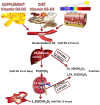Hormones and Aging: An Endocrine Society Scientific Statement
- PMID: 37326526
- PMCID: PMC11491666
- DOI: 10.1210/clinem/dgad225
Hormones and Aging: An Endocrine Society Scientific Statement
Abstract
Multiple changes occur across various endocrine systems as an individual ages. The understanding of the factors that cause age-related changes and how they should be managed clinically is evolving. This statement reviews the current state of research in the growth hormone, adrenal, ovarian, testicular, and thyroid axes, as well as in osteoporosis, vitamin D deficiency, type 2 diabetes, and water metabolism, with a specific focus on older individuals. Each section describes the natural history and observational data in older individuals, available therapies, clinical trial data on efficacy and safety in older individuals, key points, and scientific gaps. The goal of this statement is to inform future research that refines prevention and treatment strategies in age-associated endocrine conditions, with the goal of improving the health of older individuals.
Keywords: adrenal; androgen; diabetes; endocrinology; estrogen; growth hormone; osteoporosis; thyroid; vitamin D; water metabolism.
© The Author(s) 2023. Published by Oxford University Press on behalf of the Endocrine Society. All rights reserved. For permissions, please e-mail: journals.permissions@oup.com.
Figures












Comment in
-
Balancing hormonal shifts: exploring the impact of ageing and dietary restriction.Lancet Diabetes Endocrinol. 2023 Dec;11(12):884-886. doi: 10.1016/S2213-8587(23)00300-5. Epub 2023 Nov 2. Lancet Diabetes Endocrinol. 2023. PMID: 37924831 No abstract available.
References
-
- United Nations, Department of Economic and Social Affairs, population division 2019. World Population Ageing 2019: Highlights (ST/ESA/SER.A/430).
-
- Zadik Z, Chalew SA, McCarter RJ Jr, Meistas M, Kowarski AA. The influence of age on the 24-hour integrated concentration of growth hormone in normal individuals. J Clin Endocrinol Metab. 1985;60(3):513‐516. - PubMed
-
- Giustina A, Veldhuis JD. Pathophysiology of the neuroregulation of growth hormone secretion in experimental animals and the human. Endocr Rev. 1998;19(6):717‐797. - PubMed
MeSH terms
Substances
Grants and funding
LinkOut - more resources
Full Text Sources
Medical

